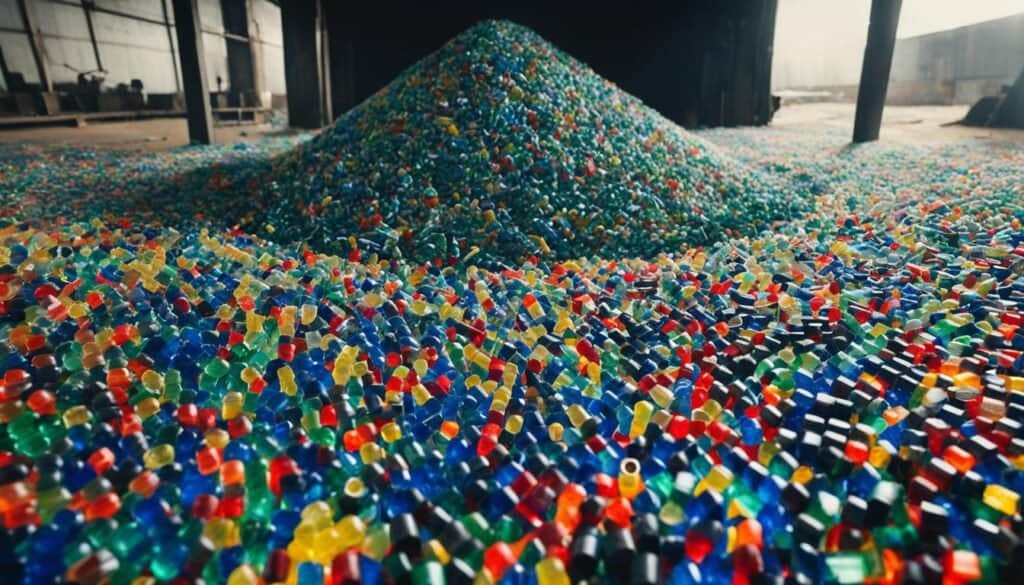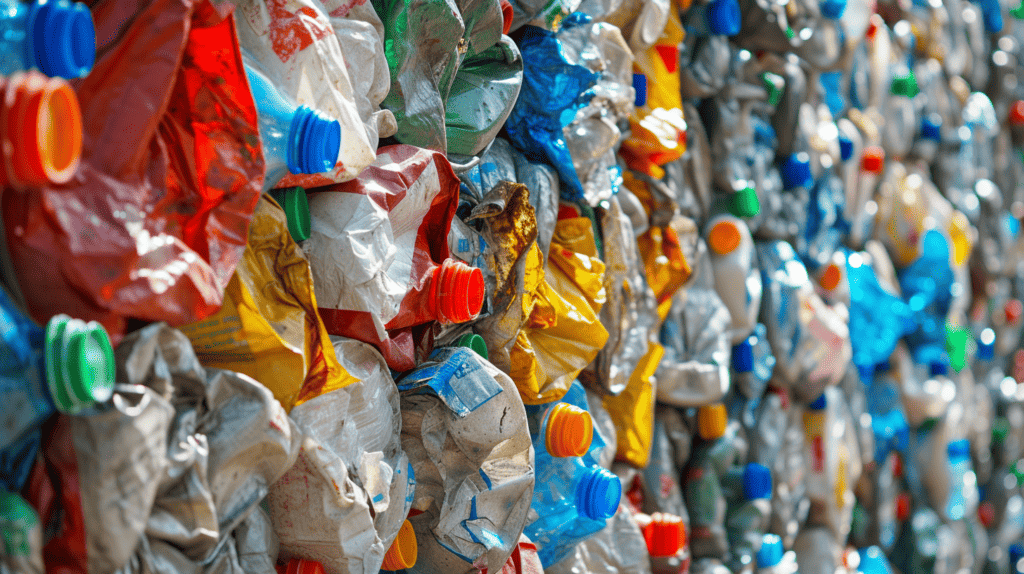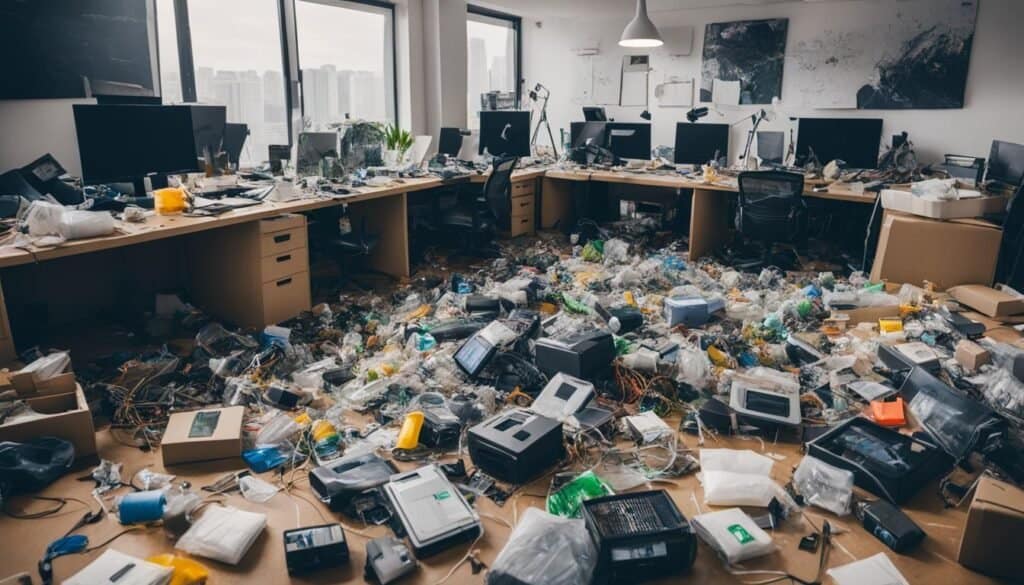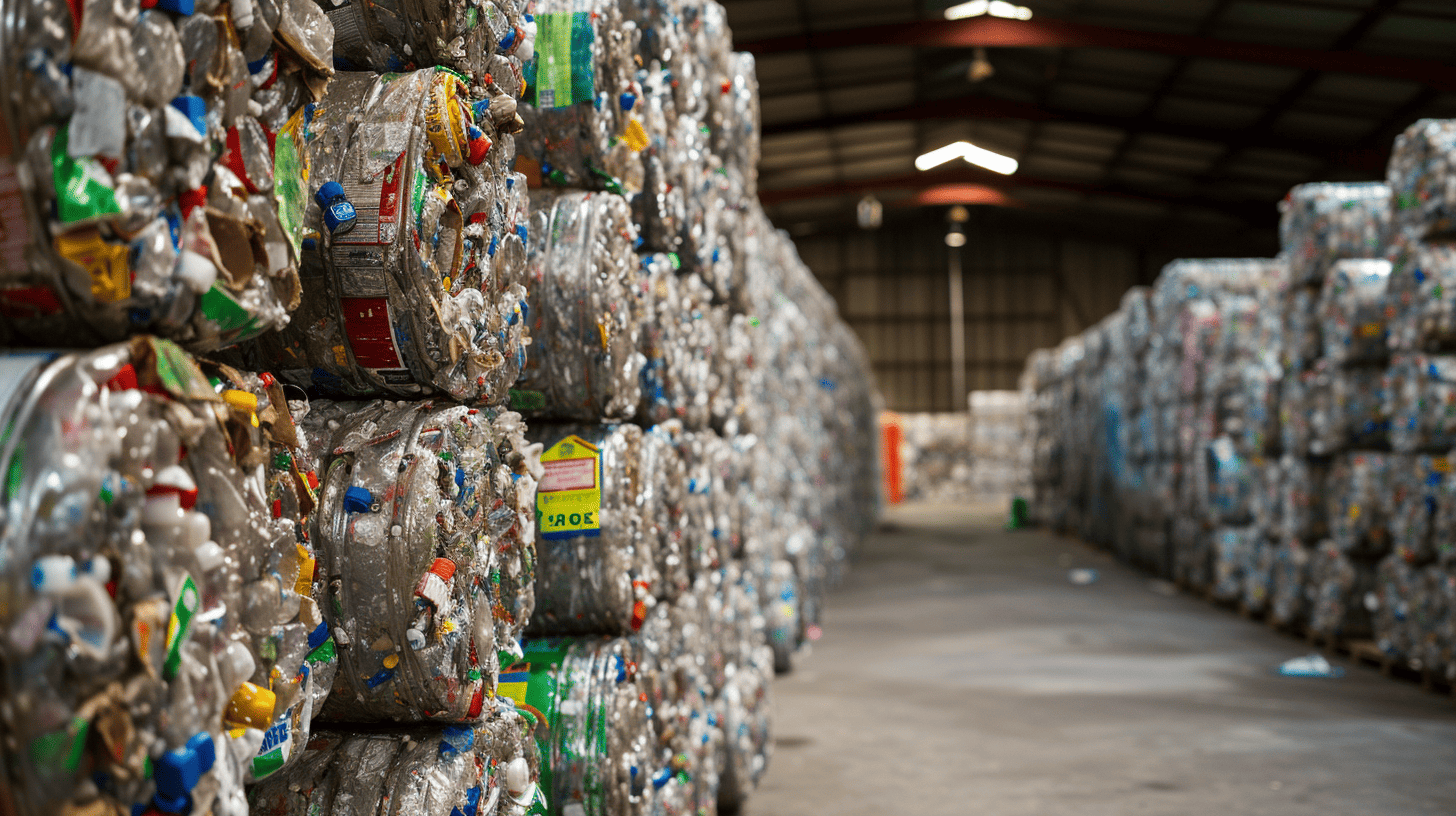In recent years, I have noticed a significant shift towards waste reduction and sustainability in our society. This push for a greener planet has fueled the emergence of innovative solutions to minimize landfill waste and promote sustainable practices.
Product innovation plays a crucial role in driving these changes, as new technologies help modernize waste management systems and tackle critical issues, such as the rising waste generation and its negative impact on the environment.
Key Takeaways
- Product innovation is at the forefront of waste reduction and sustainability efforts.
- Advanced technologies, such as AI and machine learning, contribute to optimizing waste management systems and reducing landfill waste.
- Collaborations between private enterprises and governments lead to effective policies for eco-friendly waste management and recycling.
- Sustainable product design prioritizes resource conservation and the reduction of environmental impacts.
- The successful implementation of circular economy practices requires an overhaul of manufacturing, supply chain, and consumer behavior to reduce waste generation.
Understanding Waste Management: The Current Global Situation
Today’s global waste management situation is alarming, with an uptick in waste generation due to rising population and consumption rates. Traditional disposal methods, predominantly landfills, pose grave environmental threats such as soil pollution, groundwater contamination, and significant greenhouse gas emissions. Environmental Protection Agency and other governmental bodies worldwide are recognizing these hazards and taking necessary action.
Authorities are vigorously regulating waste reduction, promoting reusing and recycling initiatives, and investing in novel waste management practices and recycling technologies. These interventions aim to pivot the current trajectory towards a path where waste management aligns with ecological sustainability and reduced climatic repercussions.
- Encouraging recycling programs in communities and businesses.
- Supporting the development of advanced recycling technologies to increase material recovery and recycling rates.
- Setting strict regulations on landfill use and emissions to promote alternative disposal methods.
- Raising awareness about the importance of sustainable waste management and individual responsibility.
Increased collaboration with industry leaders, researchers, and community stakeholders is critical to driving progress in addressing the current waste challenges. By fostering an environment where innovation thrives and best practices are shared, the global community can transition towards a more sustainable and resilient waste management system.
The Coffee Cherry Company has innovated a process to transform coffee cherry waste into flour, creating a new ingredient for drinks and baked goods, thus tackling the issue of waste on coffee plantations.
It’s not just about managing the waste we create; it’s about rethinking our consumption patterns and striving towards a circular economy where resources are continually utilized, and waste generation is minimized.
Understanding the current global waste management situation is vital for creating and implementing effective, sustainable solutions to capitalize on advanced technologies and foster collaboration. As a global community, we must embrace our collective responsibility and work towards a future where sustainable waste management practices prioritize environmental protection and responsible resource consumption.
Embracing Artificial Intelligence for Efficient Waste Reduction
Artificial intelligence has revolutionized various industries, and waste management is no exception. AI is playing a vital role in advancing waste reduction by improving waste segregation and collection processes. By utilizing artificial intelligence to optimize waste management systems, significant strides are being made to protect the environment and reduce harmful waste streams.
The Role of AI in Waste Segregation and Collection
Waste segregation and collection are critical aspects of efficient waste management. The use of AI-powered waste segregation robots helps accelerate recycling rates by enabling high-precision sorting. This not only minimizes human intervention, but also improves the overall recycling process. Companies like AMP Robotics and GreyOrange have pioneered robotic waste-sorting systems that enhance waste segregation capabilities while reducing costs.
Another essential aspect of AI in waste management is optimizing waste collection. Through AI-integrated systems that analyze data on waste generation patterns, better waste collection routes and schedules can be formulated. This results in improved operational efficiency, reduced emissions, and decreased fuel consumption associated with the waste management fleet.
AI-Powered Waste Analytics for Streamlined Operations
Waste analytics has been significantly improved with the introduction of AI-powered platforms. By providing real-time insights into waste streams, AI allows for more informed decision-making and effective resource allocation. Companies like ENEVO and Compology offer AI-driven waste analytics solutions that enable waste management providers to enhance their services, including container monitoring, dynamic routing, and predictive maintenance.
One of the primary benefits of AI-powered waste analytics is the ability to forecast waste generation patterns. Through predicting future waste trends, organizations can better prepare, strategize, and allocate resources. This not only increases operational efficiency but also helps reduce the amount of waste that ends up in landfills.
| AI Solution | Company | Application |
|---|---|---|
| Waste Segregation Robots | AMP Robotics GreyOrange | Improving recycling rates by enhancing waste segregation capabilities |
| Waste Collection Optimization | Enevo | Analyzing patterns and refining routes, leading to fuel savings and reduced emissions |
| Waste Analytics | Compology | Container monitoring, dynamic routing, and predictive maintenance |
In conclusion, AI plays an essential role in enhancing waste management and promoting efficiency in waste reduction. Through innovations in waste segregation, collection, and analytics, organizations can significantly reduce the waste streams entering landfills and minimize their environmental impact. Embracing artificial intelligence in waste management is a step towards creating a sustainable future for generations to come.
Innovative Recycling Technologies Transforming the Industry

The recycling industry is currently experiencing significant changes as a result of the introduction of robotics and advanced machinery that elevate the efficiency of recycling processes. These innovative recycling solutions play a critical role in the promotion of circular economy principles by maximizing the re-utilization of materials and reducing overall waste generation.
One example of waste management innovation is the implementation of artificial intelligence (AI) and machine learning in recycling processes, improving both the speed and accuracy of sorting waste materials. Other new recycling methods include optical sorting technology and advanced separation techniques, which help streamline waste management systems and support waste reduction initiatives.
Automation and smart technology deployments have not only improved the output quality of recycling facilities but also made waste streams more manageable, and less detrimental to the environment. This industry-wide metamorphosis prioritizes waste reduction, bolstering efforts to reduce waste generation on a global scale.
These innovative technologies are transforming the recycling industry by increasing efficiency, reducing waste generation, and supporting the principles of the circular economy.
Let’s take a closer look at some of the groundbreaking recycling technologies:
- Advanced Material Recovery Facilities (MRF): employing state-of-the-art technology for better material sorting.
- Waste-to-energy systems: transforming non-recyclable waste into clean energy.
- Biopolymers: eco-friendly alternatives to traditional plastics, like PLA or PHA.
- Chemical recycling: breaking down plastics into their molecular components to create new products.
| Technology | Impact on Recycling Processes | Benefits |
|---|---|---|
| Advanced MRFs | Enhanced automated sorting and waste diversion capabilities. | Increased recycling rates, reduced waste in landfills, and lower carbon emissions. |
| Waste-to-energy systems | Conversion of non-recyclable waste into energy resources. | A sustainable waste management solution, reducing waste in landfills and providing an alternative energy source. |
| Biopolymers | Innovative materials designed for a wide range of applications. | Reduced reliance on fossil fuels, reduced plastic pollution, and enhanced biodegradability. |
| Chemical recycling | A more versatile recycling process for a variety of plastic types and products. | Promotes circularity in plastics, reduces waste, and minimizes environmental impact. |
It is clear that innovative recycling technologies are revolutionizing the industry and have the potential to create meaningful, positive environmental impacts. By embracing these advancements and supporting waste reduction initiatives, we can continue to strive for a sustainable future in line with circular economy principles.
Waste Reduction Through Product Innovation

Product innovation is essential for sustainability as it promotes the creation of environmentally friendly products that require fewer resources and generate less waste. This approach not only benefits the economy and society but also aligns with sustainable principles. Key aspects of product innovation include renewable materials, design for circularity, eco-efficiency, and considering a product’s lifecycle impacts.
Planetarians showcases an innovative approach to waste reduction by processing sunflower seed oilcake, usually used as animal feed, into a high-protein human food ingredient, transforming waste into a nutritious product.
Successful companies such as Tesla, Patagonia, and Beyond Meat demonstrate the positive influence of product innovation on waste reduction. By continuously striving to develop sustainable products, they reaffirm the significance of integrating sustainability from conception to launch. These industry leaders emphasize the potential of products to contribute to environmental and social sustainability while creating new market opportunities and growth.
Innovative product design primarily focuses on sustainability, fostering the development of products that reduce waste and minimize resource utilization.
- Renewable materials: Harnessing renewable resources instead of finite raw materials reduces resource depletion and waste generation.
- Design for circularity: Incorporating modularity, reparability, and recyclability within product designs enables multiple lifecycles, extending product life and minimizing waste.
- Eco-efficiency: Finding ways to improve resource and energy efficiency throughout the production process lowers environmental impact and reduces waste.
- Product lifecycle impacts: Evaluating and minimizing the environmental footprint of a product throughout its lifecycle supports informed decisions about resource utilization and optimization of production processes.
As more organizations adopt sustainability in innovation, the impact on waste reduction and the development of eco-friendly products will continue to rise. Encouraging companies to pursue sustainable product design guarantees a future where both the environment and society benefit from innovations that reduce waste and preserve our planet’s resources.
The Impact of Government Policies on Sustainable Waste Management
Government policy plays a crucial role in promoting sustainable waste management practices. By implementing environment-focused regulations and offering incentives for green technologies, governments can significantly influence the waste management industry and shape eco-friendly practices. Key regulations and policies, such as the Resource Conservation and Recovery Act and the Clean Air Act, provide a solid foundation for organizations to prioritize waste reduction and responsible product development.
Regulations Encouraging Eco-Friendly Product Development
Various regulatory frameworks are designed to encourage the development of environmentally friendly products. The Extended Producer Responsibility (EPR) system, for instance, requires product manufacturers to take responsibility for the end-of-life management of their products. Such policies inspire companies to design and produce goods that are easier to dispose of or recycle, reducing potential waste generation.
The Lead-Based Paint Hazard Reduction Act is another example of an eco-friendly regulation aimed at minimizing the adverse environmental impact arising from hazardous materials in consumer products.
Government Incentives for Green Technology Adoption

Government interventions in the form of incentives and financial support serve as an impetus for organizations to adopt green technologies in waste management. In the United Kingdom, the Waste and Resources Action Programme (WRAP) offers strategic support and funding to businesses to facilitate eco-friendly innovations. India’s EPR framework and its inclusion of recycling targets and Extended Producer Responsibility Authorization (EPRA) catalyze manufacturers to embrace new recycling technologies and adopt greener product designs.
By instituting targets and providing support, governments propel innovations including resource-efficient product development and green technology implementation, paving the way towards enhanced sustainability.
In conclusion, government policies and regulations play an instrumental role in shaping the direction and pace of sustainable waste management worldwide. The combination of eco-friendly regulations, financial incentives, and targeted support drives innovations and encourages manufacturers to employ resource-efficient product development processes, adopt green technologies, and design solutions that minimize waste generation and environmental impact.
Case Study: Amazon’s Approach to Minimizing Operational Waste
Amazon is a prime example of a company making significant strides in operational waste reduction and efficient Amazon waste management. They have tackled the problem from different angles, such as optimizing design and resources to avoid waste generation, pursuing reduction strategies through increased product durability and resale opportunities, and implementing a waste hierarchy in business operations.
Emphasizing reuse through repair, repurposing, and donation, Amazon also ensures recycling and composting are part of their corporate sustainability initiatives. One of their notable achievements is the implementation of machine learning-driven packaging innovations. This approach has enabled them to reduce packaging weight per shipment by an average of 41% since 2015, resulting in more than 2 million tons of material reduction.
Furthermore, Amazon has established initiatives like Amazon Second Chance, which provide customers with multiple options for recycling, repairing, or trading in items. By doing so, they increase the adoption of sustainable behavior and contribute to reduced resource use. These efforts have also brought about supply chain efficiencies.
Note: Amazon’s focus on waste reduction not only aligns with the company’s commitment to sustainability but also serves as a valuable example for other organizations striving to minimize their environmental impact.
Overall, Amazon’s approach to minimizing operational waste highlights the importance of a comprehensive strategy that includes waste avoidance, reduction, reuse, recycling, and composting. By leveraging innovative technologies and staying committed to sustainable practices, Amazon continues to push the boundaries of waste management and serve as a model for others in the industry.
Advancements in Sustainable Packaging Solutions
Sustainable packaging has witnessed remarkable progress in recent years, particularly in reducing materials and adopting biodegradable alternatives. Companies like Amazon have leveraged machine learning and supplier partnership optimizations to minimize packaging waste and carbon emissions. These innovations not only facilitate material reduction but also enhance recyclability, enabling easy curbside recycling. Embracing innovative packaging materials is essential in transitioning towards eco-friendliness and alleviating stress on waste management systems.
Reducing Packaging Materials Through Design
Design plays a crucial role in achieving sustainable packaging goals. By optimizing packaging design to minimize excess materials, companies can significantly reduce their waste generation and environmental impact. For instance, companies can adopt lightweight or reduced-size packaging without compromising the product’s safety and integrity. Integrating materials innovation and design strategies ultimately leads to a more sustainable supply chain and carbon emissions reduction.
Adoption of Biodegradable and Recyclable Materials
Transitioning to more sustainable packaging solutions also involves using biodegradable and recyclable materials. Companies are increasingly exploring various biodegradable packaging solutions, such as bioplastics derived from cornstarch or other renewable resources, as an alternative to conventional petroleum-based plastics. Similarly, adopting recyclable packaging ensures that materials can be easily repurposed, reducing waste and facilitation curbside recycling.
| Material Type | Examples | Benefits |
|---|---|---|
| Biodegradable Materials | Bioplastics, PLA, PHA, paper, cardboard | Decomposes naturally, reduces reliance on fossil fuels, lower environmental impact |
| Recyclable Materials | Aluminum, PET plastic, glass, cardboard, paper | Reduces waste, conserves resources, supports circular economy, can be repurposed multiple times |
| Reduced Materials | Optimized packaging design, lightweight materials, minimal excess material | Decreases waste generation, lowers carbon emissions, reduces resource consumption |
By combining innovative design, biodegradable materials, and increased recyclability, the packaging industry can make remarkable strides towards achieving sustainability goals and reducing the strain on waste management systems.
Navigating the Challenges and Opportunities in Sustainable Product Innovation

The pursuit of sustainable product innovation requires overcoming numerous challenges, ranging from balancing profitability and environmental responsibility to the complexities of sourcing sustainable materials. Nevertheless, by employing systems thinking and embracing opportunities, businesses can effectively navigate these hurdles and create products that address the growing demand for eco-conscious goods while remaining competitive in the market.
Trade-offs Between Profitability and Environmental Responsibility
One of the primary challenges businesses face when embarking on sustainable product innovation is striking the right balance between profitability and environmental responsibility. Adopting eco-friendly processes and materials may affect production costs, leading to profitability trade-offs. To overcome this challenge, organizations can emphasize the long-term benefits of sustainable practices, such as improved brand reputation and customer loyalty, while seeking more affordable sustainable alternatives and identifying areas for cost-savings in other aspects of the business.
The Complexities of Sustainable Material Sourcing
Another significant hurdle in sustainable product innovation is tackling the material sourcing complexity. Identifying and procuring eco-friendly materials often involve thorough research, supplier partnerships, and navigating regulatory requirements. To address this challenge, businesses can leverage networks and collaborate with suppliers and industry experts. They can also focus on transparency and traceability in their supply chains to ensure that they adhere to responsible procurement practices and effectively contribute to circular economy innovation.
In conclusion, sustainable product innovation calls for a comprehensive understanding of the intertwined challenges and opportunities businesses face in navigating the path towards sustainability. By employing systems thinking and embracing interdependencies, businesses can successfully develop eco-friendly, market-competitive products, and contribute to a more sustainable future.
Circular Economy Practices: From Theory to Action
Moving from the theoretical concept to the practical implementation of the circular economy requires actioning zero-waste initiatives and rethinking traditional production and consumption patterns. Lifecycle analysis and sustainably-focused design practices prioritize resource conservation and encourage the continual use of resources, embodying the principles of circular economy implementation.
Transitioning to a circular economy demands a substantial shift in manufacturing, supply chains, and consumer behavior. This evolution results in a significant advance in environmental stewardship and socio-economic value creation. In this process, eco-design plays a crucial role, considering the entire lifecycle of products and materials – from production and consumption to waste management and reintegration into the system as new resources.
To successfully adopt sustainable consumption and production practices, companies must focus on:
- Reducing the use of raw materials through improved efficiency and product design
- Maximizing the lifespan of products and materials through strategies such as repair, remanufacturing, and recycling
- Encouraging consumers to adopt sustainable lifestyle habits, including waste reduction and conscious purchasing decisions
Implementing circular waste management systems is another crucial aspect of transitioning to a circular economy. These systems prioritize waste prevention and resource maximization by targeting the root causes of waste generation instead of merely disposing of waste and creating new materials.
Overall, embracing the principles of a circular economy offers numerous benefits, including:
- Reduced environmental impacts due to decreased resource extraction and waste generation
- Increased business innovation driven by the need for new sustainable products and services
- Creation of new job opportunities in the fields of waste management, recycling, and remanufacturing
- Improved social equity through more accessible and sustainable goods and services
By taking practical steps to transition from the traditional linear production and consumption model to a circular economy, we can collectively work towards a more sustainable future aligned with the priorities of resource conservation, waste reduction, and environmental stewardship.
Conclusion on Waste Reduction Through Product Innovation
In conclusion, waste reduction innovation is crucial in crafting a sustainable future. Our rapidly evolving world necessitates the necessity for effective environmental stewardship, which can be achieved through eco-friendly initiatives led by private enterprises and government policies. By adopting sustainable operations, we’re able to lessen our ecological footprint and cultivate a resource-efficient global community.
As we move forward, the future of waste management relies on our commitment to environmental sustainability. This journey demands an ongoing commitment to innovative waste strategies, bolstered by technological advancements, government incentives, and consumer engagement. By embracing forward-looking approaches, we can envision a world where the protection of our environment is not merely a priority but a way of life.
Ultimately, the pursuit of environmental sustainability is a constantly evolving challenge that requires constant innovation and collaboration between governments, businesses, and individuals. Through the adoption of sustainable practices and waste reduction initiatives, our collective efforts will unify towards a cleaner, greener, and more sustainable world.
FAQ on Sustainability
Q: What are some innovative technologies for waste reduction in the food industry?
A: Some innovative technologies for waste reduction in the food industry include smart waste bins, inventory management systems, and efficient packaging solutions that minimize waste during the production and distribution processes.
Q: How can product innovation help minimize food waste in the supply chain?
A: Product innovation can help minimize food waste in the supply chain by improving inventory management, optimizing production processes to reduce overproduction, and developing packaging solutions that extend the shelf life of perishable goods.
Q: What are the strategies for reducing emissions through waste reduction?
A: Strategies for reducing emissions through waste reduction include implementing energy-efficient production processes, utilizing sustainable packaging materials, and optimizing transportation and logistics to minimize the environmental impact of the supply chain.
Q: What role do innovative solutions play in reducing food waste?
A: Innovative solutions play a crucial role in reducing food waste by introducing advanced technologies for waste tracking and management, designing sustainable packaging alternatives, and developing efficient methods for food preservation and storage.
Q: How can businesses effectively reduce their environmental impact through waste reduction?
A: Businesses can effectively reduce their environmental impact through waste reduction by implementing cost-effective recycling programs, adopting innovative waste management technologies, and collaborating with suppliers to minimize waste generation in the first place.
Q: What are the benefits of reusing and repurposing materials to minimize waste?
A: The benefits of reusing and repurposing materials to minimize waste include reducing the need for raw material extraction, lowering waste disposal volumes, and encouraging sustainable practices throughout the product life cycle.
Q: What are the common inefficiencies in current waste management practices?
A: Common inefficiencies in current waste management practices include overproduction, inefficient inventory management, lack of standardized waste disposal methods, and suboptimal utilization of recycling and composting facilities.
Q: How can prevention and reduction strategies help in minimizing the waste generated by businesses?
A: Prevention and reduction strategies can help minimize the waste generated by businesses by focusing on production efficiency, optimizing inventory levels, and implementing waste prevention measures to minimize unnecessary material usage and disposal.
Q: What are some effective strategies for waste disposal and management in product innovation?
A: Some effective strategies for waste disposal and management in product innovation include utilizing advanced waste tracking systems, implementing sustainable waste disposal methods, and investing in innovative waste-to-energy technologies to minimize the environmental impact of waste disposal.
Q: How can businesses integrate waste reduction into their supply chain to improve sustainability?
A: Businesses can integrate waste reduction into their supply chain to improve sustainability by collaborating with suppliers to reduce overproduction, implementing efficient inventory management systems, and optimizing transportation and logistics to minimize the generation and disposal of waste throughout the product life cycle.





Leave a Reply